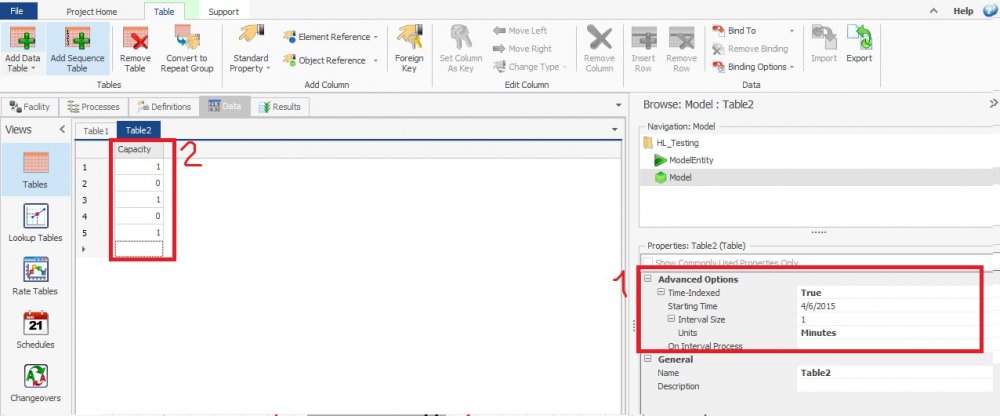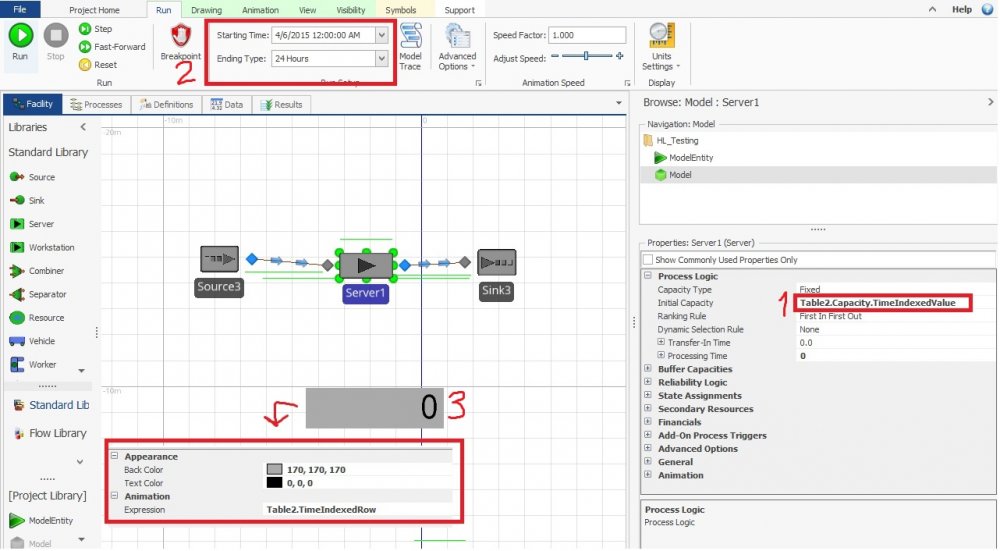Search the Community
Showing results for 'time blocked on network'.
-
HI I am a fairly new user and please forgive my confusion. I am working on a project where there are different vehicles coming on different times throughout the night. (for resurfacing etc) I created Arrival table correctly, entered date time values accordingly. The quantity of each vehicle type required is 1. Routing Logic is defined too. I used a Token process as well to guide source. BUT for some reason, when I run the model, all vehicles leave the source at once and then 1st vehicle type keep coming after every hour. BTW it works well if I use no Nodes and simple Source to Sink Path, However, when there are nodes, it mess up and all vehicles leave source at once. Can anyone please tell me what am I doing wrong ? Huge thanks in advance P.S I have attached my current model as well 4 vehicles on time (trying).spfx
-
Hello I need to change the processing time base on the number of workers available. This should could change during the simulation. I have already solved to change it before to start the simulation, but I cannot do it dynamically. One task is performed in one hour by one worker, but if after 30 min, a second worker is release and come to help, both will finish the task in 45 minutes. Viceversa, if at the beginning of the simulation there are two workers, but one have to go to another task, the worker that stay in the server will take more time to perform the task.
-
Is there any way I can define a maximun waiting time in a queue? So, if the time waiting for an entity is bigger than the setted one, a message of error or collapse appears. Thanks!
-
Hello! I am modeling a wash station that takes 30 minutes for the first piece, and an additional 5 for each piece after that(so a batch of 3 would take 40 minutes, a batch of 6 would take 55 minutes, and so on) but I'm having some trouble putting this into a processing time. The added problem is that the number of entities changes. Currently I'm using a source that produces one "shipment" a day with "Entities per arrival" set as "random.triangular(3,13,19)" which is working fine for my quantity, but I don't know how to relate that into the processing time of the next workstation. Thanks!
-
As a response value for my experiments i want the total idle time of all servers during the experiment. But i have around 100 servers and don't want to type for every server a expression like "Server6.ResourceState.TotalTime( 0 )" and sum them up. Is there an easier way? I would like to use only one expression which gives my the idle time of all servers. Something like All_servers.ResourceState.TotalTime(0).
-
Hello Asagan: I have a question re: how to assign a specific product type onto a Server based on a SCHEDULE.. Products coming from S1,S2,S3,S4 randomly and queue before ServerA, and ServerA can only work on a spefic Type based on the SCHEDULE's time period,means it need to choose specific product in the QUEUE ..thanks !! Of course this can be made more complex, but so far ,this is the question....
-
Hello, I'm using a time-indexed table in a model I'm working on, but it's not working as intended. I created a testing model to test the time-indexed referencing and it's not working either. In the testing model, I have a simple SOURCE-SERVER-SINK model to test the Time-Indexed referencing. The way I was going to do that was by giving the capacity of the server values of 1 and 0 depending on the simulation time. This way I could see that every 1 minute periods, the server would allow passing (when capacity is 1) and disallow passing (when capacity is 0). Below, in Pic1 you can see 3 things: 1) property I created on the "Initial Capacity" cell of the server, 2) simulation time starting on 4/6/2015 at 12 am, and 3) status label "Table2.TimeIndexedRow" which should return the right row it's gonna be using depending on the simulation time. Now, on Pic2, I attached a picture of my Table2, which is Time-Indexed. In this one, you can see two things: 1) Table set to time-indexed with a starting date of 4/6/2015 at 12 am (which matches the start of the simulation run) and an interval size of 1 minutes (which means that every 1 minute the table would look at the next row), and 2) Values for the property column "capacity", changing from 1 to 0 as explained before. Now, when I run this model, if the model was working correctly, the server's capacity should be 1 from 12:00 to 12:01, and changed its capacity to 0 (disallowing passing) from 12:01 to 12:02 [and then continue doing so based on the values for the column "Capacity"]. However, what happens is that the capacity is just using the 1st row value (value of 1) and using it indefinitely - even though the status label I mentioned before for Table2.TimeIndexedRow is updating to 1,2,3,4... as intended. I would really appreciate the help to solve this and answer any questions about the way I constructed this. Thanks!
-
Hi, I'm facing a difficulty setting the destination of a vehicle. My model consists of a source, a server and 4 sinks located on a network. Entities must travel by vehicle from the server to the four destinations ( 25% of all entities to each destination ), however the vehicle may only take entities to one of the locations during one trip, so not 1 to sink1 and then the rest to sink2 etc. My question is how to set the destination of the vehicle so that it will take the entities to different locations each trip it makes. To add extra difficulty there are 2 types of vehicles with different capacities. Hope u guys can help. Kind Regards, Erik
-
I want to monitor the time a server is idle as a response feature in an experiment. I think the standard Pivot Grid statistics has the "Time Starved" feature which tells me how long the server is idle. But i want the total idle time of all servers as a response in my experiment. So thought i may use a tally statistic with the value "Server1.Processing.Contents==0" but i don't know how to connect that with a property and i am not so sure if that is correct. I think that might be a common interest so maybe you have a solution for that.
-
I constructed a simple model with a single server where I used a rate table for arrivals. The server block capacity was fixed at 2. When I run this model by hand, I see that maximum holding time for the input buffer of the server is just about 24 minutes every time (but the same exact number), just as it would be if the arrival rate was constant throughout a 24-hour period. However, when I run an experiment where I defined the Server1.InputBuffer.Contents.MaximumTimeWaiting as the response variable, the result is 40 minutes for the scenario where the server capacity of 2 is 40 minutes.(I am using version 5.91) I am wondering 1) if I am confusing two different quantities (maybe the maximum holding time result is averaged by dividing by capacity, but that would be a bug, because the capacity should have no effect on the input buffer) or 2) if the randomization seed is the same for every run that I do by hand, which must be the case, because when I reduce the required replication count to 1 for the experiment, I get the same exact result for the single run that I do by hand. If that is the true reason, then I must ask where to change the randomization seed for every run.
-
I have several servers which have failures at the same time. The failure is triggered through a randomly fired event. But i also want the servers to be repaired at the same time. So first my idea was to use an Input Parameter for the "Time to Repair" section for each Server.Because i want a random distributed repair time which changes every time the servers have a failure. But it should be for all servers the same repair time time. So for example failure 1, repair time: 4 min. Failure 2, repair time: 2 min. And that for all servers. I hope you know what i mean. How can i realize that?
-
I was trying to create a electrical network by Simio, and was struggling with the components required in the networks, like bus, transmission line , transformer etc. However, I am not sure it is within the scope of Simio or not . Electricity flow is not like the mechanical flow. It is instantaneous. Can anyone suggest me regarding this. sazzad
-
I'm trying to model a transportation behavior where for every 20 entity(shipping size) accumulated at a node, I want a transporter to come pick the entities up (exactly 20 entities). However, since the requests are initiated from the same node, a single transporter comes and picks up everything if there are more than one party at the node (one party = 20 entities). But if I have two parties accumulated at the node, I want two transporters. I know setting the transporters' capacity to 20 will solve the issue, but the shipping size property can be different among nodes and I'd like this behavior to work even if the transporter's capacity is set to infinity. Any suggestions? Thanks, Selin
-
Hello, I have a quick question regarding the difference between the 2 metrics I highlighted in the attached picture. I'm done running the model and I'm not getting the results I expected, so I'm trying to go through everything and see where the problem is. What I wanna know is, what's the average time that this server, DispoToLeave, spent processing (in a busy state) entities? I really appreciate the help!
-
Hi, I'm working on a model with multiple paths and I'm using time paths to move entities. I recently noticed that the "Shortest Path" Outbound Link Rule doesn't work with time paths since it looks at the size of the path (as in, the length of the drawn segment) instead of the time it takes to travel the path. Is there any way to have a transfer node choose the time path with the shortest travel time? Thanks.
-
Hello, This is a Simio model of a logistics network where experiments are run with different number of facilities. I am trying to automate the model building (building the network) For instance, the users will specify the scenarios (experiments) with the desired quantity of facilities and the models will be built according to that information. I am guessing there is a way to dynamically create objects (nodes in this case), but linking those nodes and specifying the distances is challenging. Besides, when the number of facilities increase, the previous locations change as well. Therefore, the distances between the nodes change depending on the number of facilities the user specifies. I tried to set a reference property to the logical distance of the path object, but it is not allowed in Simio. I also considered using free space, but in that case, the objects in the model has to be located in specific places according to the physical appearance of the network. I thought of this as a significant disadvantage. Can this process be automated using SimioAPI extensions in Visual Studio? What type of approach would you suggest? Thank you. Selin
-
Hi I am trying to model a process with Server seizing a resource for fixed amount of time then releasing it before the Sever processing is over. I tried using a timer with TimeInState as an interval time to check period the resource has been busy then trigger an event after fixed time to release the resource .This has not been working and I am getting an error massage . Could any body suggest away to do this ? Thanks Malseiari
-
hello, is there any number in the simulation results which returns the average waiting time for each entity? If not how can I implement this situation easily? Thanks! Regards, Nadine
-
Hello.How is the time unit in Simio related to real time? And what is speed factor?
-
Sample model that uses dwell time at a node from a schedule
ASagan posted a topic in SI Shared Items
The attached model relates to the discussion at the following post: http://www.simio.com/forums/viewtopic.php?f=1&t=1165 I created a very basic, not quite fully functional, 'dwell time' model that calculates the dwell time based on how soon the next departure slot is according to Dave's example above. I don't feel this approach is very elegant but it can help others get started. sampleDwellTimeModel.spfx -
So this may be an easy answered question, but I'm at a roadblock. I want to have an entity wait in a server until a specific date and time. Once that date and time is reached within the model run, I need it to fire and move to the next server. This would be easy if it were one entity, but essentially a batch all arrives at different times and then needs to wait until that date/time to ALL move at the same time into a combiner. Any help would be greatly appreciated.
-
I've copied the vehicle from the standard library vehicle and revised it to include: Travel time based failures, calculated from the resource state Transporting. This failure time does not include OffShiftTransporting or FailedTransporting. These failures will occur mid-link. Distance travelled failures, recorded from the link length when the transporter arrives at the end of the link. These failures can only occur at the end of a link. Created in Sprint 4.72. VehicleWithTravelTimeBasedFailures.zip VehicleWithTravelTimeBasedFailures.zip
-
The standard library vehicle has the option of a loading and unloading time per entity, but it is often difficult to model a situation where a vehicle stops for a specified time (like a bus or train). This object (with an example model) adds a single reference property and a single step to the standard Vehicle to allow you to specify that time. Smple, but convenient. VehicleWithFixedLoadTime.zip Done using Sprint 68







